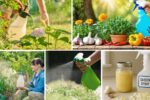When it comes to plants that beautifully combine ornamental appeal with culinary and medicinal value, few herbs rival sage (Salvia spp.). Known for their aromatic foliage, striking flowers, and rich history in kitchens and healing gardens, sage plants come in many fascinating varieties. Whether you’re after bold blooms for pollinators, soothing leaves for teas, or savory herbs for roasts, there’s a sage plant for every garden.
Let’s explore 10 stunning sage plants that offer both beauty and flavor, transforming your garden and kitchen alike.

1. Common Sage (Salvia officinalis)
The classic culinary sage, Salvia officinalis, is a must-have for herb gardens. Its soft, gray-green leaves carry a rich, earthy aroma and flavor, making it a favorite in stuffings, meats, and herbal teas. In late spring, it produces delicate violet-blue flowers that attract bees and butterflies. This perennial herb thrives in well-drained, sunny spots and is drought-tolerant once established. Besides its culinary uses, Common Sage has a long history in folk medicine for sore throats and digestion, making it a multifunctional star in the garden.

2. Purple Sage (Salvia officinalis ‘Purpurascens’)
Purple Sage offers the same robust flavor as Common Sage but with striking purplish-bronze leaves that lend bold color to herb beds and mixed borders. It’s both beautiful and practical, with leaves that can be used fresh or dried in cooking. Purple Sage blooms in early summer with lavender-blue flowers, creating a magnet for pollinators. This variety is especially valued for its ornamental foliage, which deepens in color during cool weather. Grow it in full sun with well-drained soil for the healthiest, most flavorful leaves.

3. Golden Sage (Salvia officinalis ‘Icterina’)
If you’re after an eye-catching sage variety, Golden Sage delivers with its variegated green and yellow leaves. Its lemon-lime tinted foliage adds brightness to garden beds and containers, providing year-round color. The leaves offer a milder flavor than Common Sage, ideal for lighter dishes and herbal infusions. In early summer, it produces soft violet blooms, drawing beneficial insects. Golden Sage prefers sunny spots and benefits from regular trimming to maintain its compact, bushy shape and vibrant coloration.

4. Tricolor Sage (Salvia officinalis ‘Tricolor’)
Tricolor Sage lives up to its name with a stunning blend of green, cream, and rosy-purple foliage. It’s one of the most ornamental sages available, offering visual interest even before it blooms. Though slightly less pungent than Common Sage, its leaves are still flavorful and can be used in cooking and teas. Tricolor Sage produces lilac-colored flowers in summer and grows well in containers, borders, and herb spirals. It prefers full sun and well-drained soil, and regular pruning will keep its colorful leaves fresh and vibrant.

5. Pineapple Sage (Salvia elegans)
A fragrant favorite, Pineapple Sage surprises with bright green leaves that release a sweet, pineapple-like scent when crushed. In late summer to autumn, it bursts into vivid red tubular flowers, beloved by hummingbirds and pollinators. Though its leaves have a milder culinary use, they’re wonderful for herbal teas, fruit salads, and flavored syrups. Pineapple Sage thrives in sunny, sheltered spots and makes an excellent addition to ornamental or edible gardens. It’s a tender perennial in colder regions, often grown as an annual.

6. Clary Sage (Salvia sclarea)
Clary Sage is celebrated for its tall, showy spikes of pink, lavender, and white flowers, which appear in early to midsummer. Its large, wrinkled leaves are aromatic and have historically been used in herbal remedies and perfumes. While it’s less common in culinary use, the young leaves can flavor soups or teas. Clary Sage is a biennial or short-lived perennial that thrives in sunny, well-drained spots and attracts plenty of bees and butterflies. Its bold blooms and medicinal past make it a fascinating addition to herbal borders.

7. Mexican Bush Sage (Salvia leucantha)
A show-stopper in late-season gardens, Mexican Bush Sage boasts velvety, arching spikes of purple and white flowers from late summer into fall. Its slender, gray-green leaves are aromatic, though not typically used in cooking. This sage is loved for its ornamental beauty and ability to attract hummingbirds, bees, and butterflies. It thrives in sunny, well-drained areas and is drought-tolerant once established. In cooler regions, it’s grown as an annual or overwintered indoors. Mexican Bush Sage brings lush texture and late-season color to mixed plantings.

8. Greek Sage (Salvia fruticosa)
Also known as Three-Lobed Sage, Greek Sage is a staple in Mediterranean kitchens, prized for its slightly sweeter, milder flavor compared to Common Sage. Its silvery-green, felted leaves offer a beautiful contrast in herb beds, and it produces soft lavender flowers in late spring. Greek Sage is often used in herbal teas, roasts, and traditional remedies for colds and digestion. This drought-tolerant perennial thrives in poor, rocky soils and full sun, making it ideal for xeriscaping and coastal gardens.

9. Jerusalem Sage (Phlomis fruticosa)
Though technically a member of the Phlomis genus, Jerusalem Sage is often included in sage collections for its aromatic leaves and similar growing habits. It features woolly, gray-green foliage and produces clusters of bright yellow, tubular flowers in late spring and early summer. While not typically used in cooking, it has a long history in Mediterranean herbal medicine. This drought-tolerant shrub adds structure and color to dry gardens and pairs beautifully with lavender, rosemary, and other Mediterranean herbs.

10. Cleveland Sage (Salvia clevelandii)
Cleveland Sage is a California native known for its intensely aromatic, gray-green leaves and striking whorls of violet-blue flowers in late spring to early summer. Its foliage releases a sharp, earthy scent, making it a favorite in native plant and drought-tolerant gardens. While not commonly used in cooking, its leaves can be steeped for teas and aromatic infusions. Cleveland Sage thrives in hot, dry climates and poor, well-drained soils. It’s also a pollinator magnet, providing nectar for bees and hummingbirds.
Final Thoughts
Sage plants beautifully blend form and function, offering everything from bold flowers and scented leaves to culinary seasoning and ancient remedies. Whether you’re after the classic appeal of Common Sage, the sweet aroma of Pineapple Sage, or the striking visuals of Tricolor Sage, there’s a variety to suit every garden and palate.
Ready to build a vibrant, aromatic, and flavorful sage collection? These 10 sage plants will bring lasting beauty and herbal charm to your space year after year.





